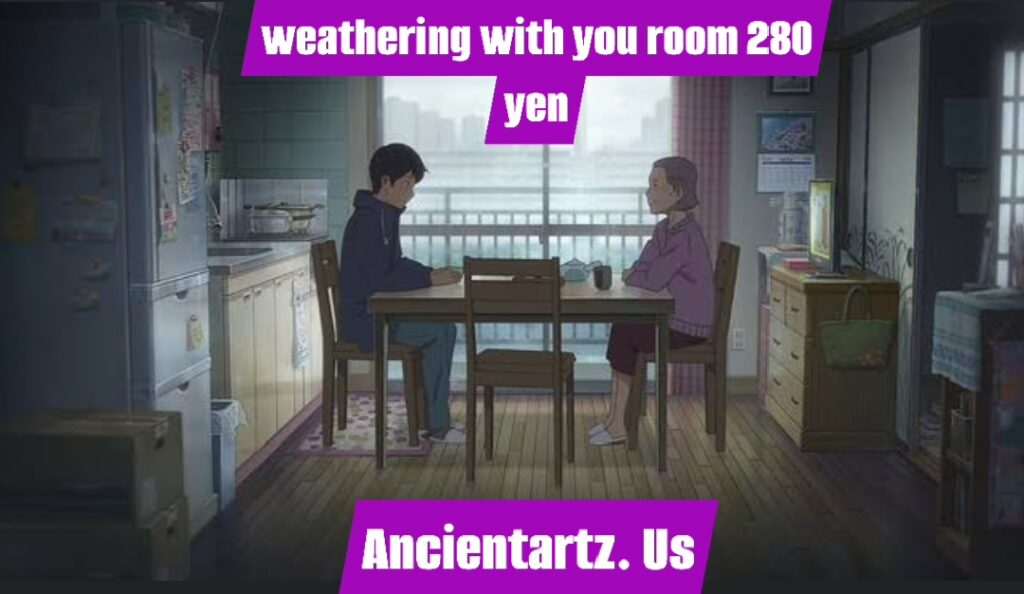Introduction
“weathering with you room for only 280 yen“ is not just a cinematic masterpiece but a deeply resonant tale of love, sacrifice, and the inexplicable bond between humanity and nature. Directed by Makoto Shinkai, this anime film delves into the story of a young boy, Hodaka Morishima, and a mysterious girl, Hina Amano, who can manipulate weather. But what makes the narrative even more enthralling is its subtle commentary on the socio-economic struggles faced by youth in urban Japan, such as affordable living spaces, including the infamous “280 yen room.”
In Japan’s sprawling metropolis, Tokyo, where modernity intertwines with tradition, the concept of micro-living is no surprise. A room priced at only 280 yen per night isn’t just an anecdote in the film but symbolizes the larger reality of survival and sacrifice. This article explores the intricate details of “weathering with you room for only 280 yen” connecting its poignant storytelling with the broader themes of urban life, climate change, and human emotions. Dive into the layers of this artistic work as we unravel its magic.
The Unique Concept of the 280 Yen Room in “Weathering With You”
One of the most intriguing elements of the film is Hodaka’s decision to stay in a tiny, almost claustrophobic room priced at only 280 yen per night. This decision represents a stark contrast to the vibrant and fast-paced Tokyo backdrop. Such accommodations are not a figment of imagination but a reflection of the real-life “capsule hotels” and ultra-budget lodgings found in Japan. These spaces serve as a lifeline for struggling individuals who seek refuge in a city that demands exorbitant living costs.
Shinkai masterfully incorporates this realistic element to highlight the challenges faced by young adults who venture into urban centers without financial stability. Hodaka’s stay in this room portrays his initial struggles, yet it becomes a metaphor for his determination to find his purpose. The 280 yen room not only serves as a physical shelter but also symbolizes resilience and adaptability in the face of adversity.
Weather and Its Metaphoric Role in the Film
The film revolves around the enigmatic Hina, who can control the weather by praying. Her ability to bring sunshine to a perpetually rain-drenched Tokyo is both a blessing and a burden. The weather is not just an environmental backdrop but a powerful metaphor for emotional turbulence, societal challenges, and personal sacrifice.
Rain, which dominates most of the movie, serves as a symbol of despair, melancholy, and societal chaos. However, through Hina’s intervention, the temporary sunlight represents fleeting moments of happiness and hope. The balance between rain and sunshine mirrors the struggles and joys of life. Makoto Shinkai intertwines these elements to evoke an emotional response from the audience, making the weather an inseparable character in its own right.
Urban Isolation and Youth Struggles
Tokyo, despite its vibrant life and cultural allure, is portrayed in the film as a city of isolation, particularly for its youth. Hodaka’s journey to Tokyo encapsulates the dreams and struggles of countless young people seeking better opportunities in the city. However, as the film progresses, we see the harsh realities of urban life – low-paying jobs, expensive living costs, and the constant pressure to succeed.
Hodaka’s encounters with various characters, including Suga, a freelance writer, and Hina, a weather maiden, reflect different shades of urban survival. The 280 yen room becomes a focal point of this struggle. It’s a space of solitude, yet it allows Hodaka to regroup and find strength in his pursuit of purpose. The film poignantly portrays how urban life can be both a haven for dreams and a battlefield for survival.
Love and Sacrifice in “Weathering With You”
At its core, the story of Hodaka and Hina is one of profound love and sacrifice. Hina’s ability to control the weather comes at a great personal cost, as it demands her eventual ascension to the heavens, leaving behind her earthly existence. Hodaka, unwilling to accept this fate, risks everything to save her, leading to a climax that questions morality, love, and the very fabric of nature.
Their love story is not a traditional romance but one steeped in mutual understanding and the willingness to sacrifice. Shinkai uses their bond to explore themes of destiny, agency, and the human spirit’s defiance against insurmountable odds. This relationship elevates the film, making it more than just a visual spectacle but a deeply emotional narrative.
Environmental and Societal Commentary
“weathering with you room for only 280 yen” isn’t just about individual struggles; it also serves as a commentary on climate change and societal responsibility. The perpetual rain in Tokyo is symbolic of the environmental consequences of humanity’s actions. Shinkai subtly integrates this theme without making it overtly preachy, allowing viewers to interpret its significance in their own way.
Moreover, the socio-economic challenges depicted in the film, such as Hodaka’s need for low-cost accommodation and Hina’s efforts to support her younger brother, highlight the growing disparity in modern societies. The film questions the sustainability of current systems, urging viewers to think about the broader implications of their actions.
The Unforgettable Climax: Choosing Love Over the World
The climax of “weathering with you room for only 280 yen” is as heart-wrenching as it is thought-provoking. Hodaka’s decision to save Hina, even at the cost of plunging Tokyo into chaos with perpetual rainfall, raises profound moral questions. Is love worth sacrificing the greater good? Can one individual’s happiness justify the suffering of many?
Shinkai leaves these questions open-ended, allowing viewers to grapple with the complexity of the situation. This bold narrative choice sets the film apart, making it not just a tale of romance but a philosophical exploration of human priorities and ethics.
Conclusion
“weathering with you room for only 280 yen“ is a cinematic triumph that transcends the boundaries of traditional storytelling. Through its richly layered narrative, breathtaking visuals, and compelling characters, the film captures the essence of human resilience, love, and the interconnectedness of nature and humanity.
The 280 yen room, though a minor detail, serves as a powerful symbol of survival and hope amidst adversity. Hodaka’s journey, intertwined with Hina’s sacrifice, offers a poignant reminder of the beauty and fragility of life. As Tokyo drowns in rain, the film leaves viewers with a sense of wonder and introspection, urging them to reflect on their own lives and choices.
Makoto Shinkai has once again proven his mastery in creating stories that resonate on both personal and universal levels. “Weathering With You” is not just a film but an experience that lingers long after the credits roll.
FAQs About “Weathering With You”
Q1: What is the significance of the 280 yen room in the film?
The 280 yen room represents urban struggles and survival. It highlights the socio-economic challenges faced by youth in cities like Tokyo, serving as a metaphor for resilience and determination.
Q2: How does the film address climate change?
The film uses perpetual rain as a symbol of environmental imbalance and humanity’s impact on nature, subtly urging viewers to consider their responsibility toward the planet.
Q3: Why did Hodaka choose to save Hina at the cost of Tokyo?
Hodaka’s decision emphasizes the value of personal love and sacrifice, raising moral questions about prioritizing individual happiness over collective welfare.
Q4: Is “Weathering With You” connected to Makoto Shinkai’s previous works?
Yes, the film features subtle references to Shinkai’s other works, such as Your Name, creating a shared universe that fans can appreciate.
Q5: What is the message of “Weathering With You”?
The film conveys themes of love, sacrifice, resilience, and the delicate balance between humanity and nature, urging viewers to reflect on their choices and responsibilities.
Also Read This:Weathering With You: Room for Only 280 Yen – A Journey Beyond Expectations



